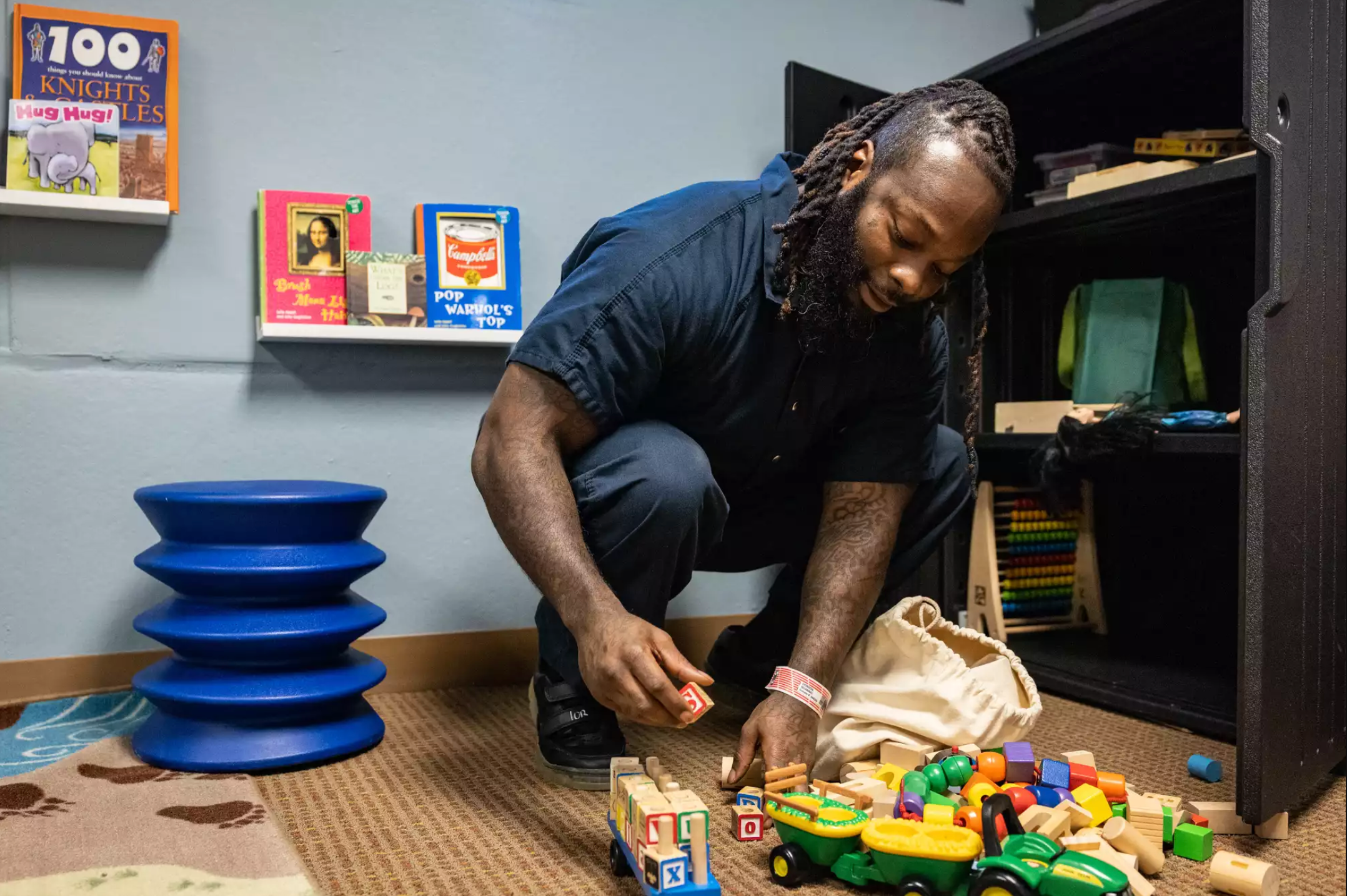‘It’s a blessing’: For jailed Minnesota parents, in-person visits with children are rare
Published 4:50 am Thursday, March 9, 2023

- Quannel “Nel” Hobson puts away building blocks his 1-year-old son plays with during parenting visits inside the Ramsey County Correctional Facility in St. Paul on Friday. Ben Hovland/MPR News
|
Getting your Trinity Audio player ready...
|
A budget proposal would expand program to allow more kids to visit parents while incarcerated
By Nina Moini
Holding the small wooden blocks his almost 2-year-old son loves to play with most when he visits, Quannel “Nel” Hobson, 31, can’t help but smile.
“He likes to throw stuff around,” Hobson said. “He doesn’t sit down.”
Hobson, who is from St. Paul, will finish his 8-month sentence at Ramsey County Correctional Facility in about one month. During this time, he said his weekly hour-long visits with his son on Sundays inside a child-friendly room at the jail have been like a lifeline. The visits give him the greatest motivation to stay on the right track.
“It’s a blessing,” Hobson said. “Every day I can’t wait to see my baby.”
Hobson’s opportunity is truly unique. Most jails in Minnesota do not allow in-person visits between parents who are inmates and their young children. The state reports an estimated 17 percent of youth in Minnesota have an incarcerated or previously incarcerated parent, making it one of the most frequently reported adverse childhood experiences.
University of Minnesota pediatrics researcher Rebecca Shlafer specializes in studying the effects of incarceration on children and families.
“This increases kids’ risk of having poor outcomes in adolescence and their own adulthood, like their own substance use, their own struggles in school and mental health problems,” Shlafer said.
The average length of stay at the Ramsey County jail is 38 days for women and 48 for men. Shlafer said although jail sentences are shorter than prison sentences, even a short jail stay of less than one year can be equally or more disruptive and harmful to children because of the uncertainty.
She says state prisons have a more uniform approach to visitations than Minnesota jails, which are run by individual counties. People serving time in prison also know the length of their stay and outcome of their case, which is not always the case in jail.
“It is really about trying to help heal some of the trauma that could have happened in the context of their parents’ incarceration,” Shlafer said. “Helping parents reconnect with their kids, helping kids understand their parents are safe. Sometimes kids don’t know where their parents went so being able to see and touch and hold them is important.”
Gov. Tim Walz’ budget proposal for the next two years includes the Minnesota Department of Health’s recommendation for $1.125 million in grants that would bring model jail practices and in-person visits to more jails.
Currently, six jails ranging in size across the state have the visitation program, including Carlton County Jail, Olmsted County Jail, Ramsey County Correctional Facility, Renville County Jail, Stearns County Jail and Sherburne County Jail.
The additional funding would add services for 15 more jails.
The services also include parenting classes and peer-to-peer support in jails. Autumn Mason gave birth to her daughter in 2014 while incarcerated at the state’s prison in Shakopee.
“I still have not many words I can use to describe the stress and mental anguish I was going through,” Mason recalled.
Since then, Mason has left prison and become a doula and peer support professional with the Minnesota Prison Doula Project, which facilitates the best practices in jails, including in-person visits with children.
“People don’t always have compassion for incarcerated people,” Mason said. “Your neighbors, educators, people in your community, everyday people have had experiences similar to mine.”
Mason supports parents in jail in meeting their specific needs around scheduling or resolving conflicts with co-parents or caregivers at home. Mason also helps give guidance about how to explain where their parent in jail has gone based on a child’s age.
The state reports 22 percent of Minnesota rural youth have experienced a parent’s incarceration. Sixteen percent of children in the Twin Cities and 14 percent of suburban youth have an incarcerated parent, according to 2019 Minnesota Student Survey data.
In the Ramsey County jail, there are currently 14 men and 10 women participating in the program. The county spends about $40,000 per year. Assistant jail superintendent Liz Reetz said budget and staffing shortages are the biggest obstacles to expanding the programs, especially in smaller counties with less money.
Reetz said the visits with children have been particularly helpful and worth the investment.
“We realized the parents were much more settled inmates while in the facility,” Reetz said.
Reetz added there has been a change in the culture at many jails since the in-person visits began in 2016 for mothers and 2019 for fathers. The visits paused for the height of the pandemic.
She said it used to be commonly believed that people who end up in jail should face the consequences, including being separated from their children.
“Actually, that has so many harmful effects on not only the individual, the family unit and ultimately the community, that it doesn’t make sense to operate in that way.”
The state reports an estimated two-thirds of adults in Minnesota jails are parents with minor children, most lived with at least one of their children before their arrest, and a majority are interested in participating in parenting education.
Hobson said while it may not be the case for every family, seeing his son has been the best thing for everyone in his family.
“I can tell he missed me a lot, it is hard for him, too, to be honest,” Hobson said. “The only thing I can do is stay on the right track, start work, I’m ready for that.”



